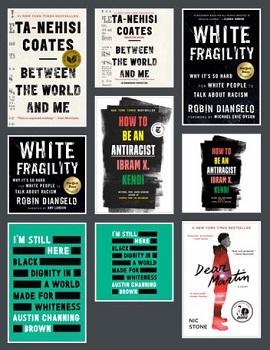As the shock wave created by the video of George Floyd’s murder continues to reverberate, people—especially white people—are asking “What can I do? How can I be an ally?” and one part of the answer is always “educate yourself about structural racism.”
To that end, these title suggestions will help get you started thinking about what it means to be antiracist and understand what structural racism is, how it came to be, and how it is experienced by people of color.
If you only have time to commit to one book, start with White Fragility: Why It’s So Hard for White People to Talk About Racism, where antiracist educator Robin DiAngelo identifies patterns of reaction by white people to the topic of racism. Often characterized by anger, fear and guilt, these learned reactions contribute to perpetuating racism. Disrupting the pattern through becoming able to recognize it invites authentic dialogue about race to begin, as well as furthering understanding about how to be part of the solution.
For a more personal perspective of the effects of racism on the lives of individuals, Austin Channing Brown’s I’m Still Here: Black Dignity in a World Made for Whiteness describes her experience growing up Black, Christian, and female in a majority-white community. Her powerful, haunting voice tells how she had to “learn what it means to love blackness” in her school, workplace and place of worship, where racism was deeply embedded.
Called “required reading” by Toni Morrison and others, and awarded the National Book Award and a finalist for the Pulitzer Prize, another very personal and provocative perspective on structural racism is Between the World and Me by Ta-Nehisi Coates (pictured). Penned as a series of letters to his teenage son, Coates moves between personal and historical events like the murders of Michael Brown and Trayvon Martin to reveal how American society contains an intrinsic system that is built to oppress black people—from slavery to mass incarceration to police brutality. A slim volume, but not necessarily a quick read; I found it required many thought-provoking timeouts to absorb his message.
A fitting conclusion to your reading would be How to Be an Antiracist by Ibram X. Kendi; Kendi takes readers beyond simple awareness of racism to help you develop an action plan. Personal stories from his life add potency to his descriptions of different types of racism and give this book a memoir-feel.
An essential thesis communicated is that it is not enough to merely be “not a racist;” rather, it is necessary to recognize the magnitude of structural racism by consciously fighting against it as an “antiracist.” Kendi’s Stamped from the Beginning: The Definitive History of Racist Ideas in America, another National Book Award winner, is also an excellent resource.
Kendi also has a youth version of Stamped from the Beginning (called Stamped: Racism, AntiRacism, and You), written with Jason Reynolds, that would be a great introduction for middle grades and older.
For teens, try Dear Martin by Nic Stone (a high school student explores how race relations have shaped his life in a series of letters written to Dr. Martin Luther King Jr.) and The Hate U Give by Angie Thomas (a teen witnesses a close friend’s death at the hands of police and the resulting impact on her life and community).
These titles and more can be found at your local library or bookstore. Whatcom County Library System (https://www.wcls.org has purchased many copies of each (some are always available) to keep the wait times down for WCLS cardholders. If you, like me, are looking for ways to better understand racism and your role in perpetuating it, these authors can guide us on this journey.
Lisa Gresham is the Collection Services Manager at the Whatcom County Library System.
(Originally published in Cascadia Weekly, Wednesday, June 3, 2020.)

